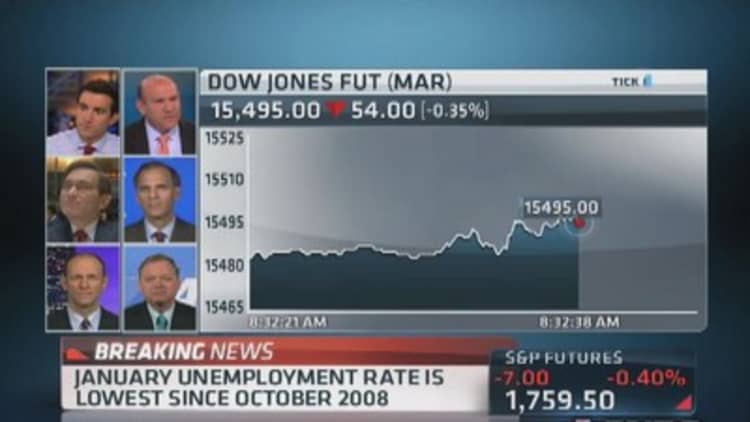
Job growth saw another weak month in January, with employers adding just 113,000 positions as frigid weather and a deluge of storms, along with a continued economic slowdown, helped dampen hiring.
The Bureau of Labor Statistics also reported Friday that the unemployment rate fell to 6.6 percent. The labor force participation rate remained mired around 36-year lows, though it edged higher to 63 percent, and some economists said that for a change the drop in the rate came for good reasons.
Economists expected 185,000 new positions were created in January, from a slightly upwardly revised 75,000 in December, with the unemployment rate holding steady at 6.7 percent.
An alternate measure of unemployment that includes discouraged and underemployed workers slid from 13.1 percent to 12.7 percent, its lowest level since November 2008.
(Read more: This is what Greenspan is really worried about …)
Markets shrugged off the number after turning negative momentarily. Futures indicated a sharply higher open on Wall Street.
"On an absolute kind of real-economy basis, this does confirm that there's probably some degree of slowness out there, but I don't think it's catastrophic," Brad McMillan, chief investment officer for Commonwealth Financial, which manages $81.6 billion for clients, said in a phone interview. "You had the same kind of differential last time where the unemployment rate is going down at the same time as we get a very disappointing number. Clearly, there's some kind of discrepancy between the establishment survey and the household survey. The best explanation for that is weather."
The household survey showed that 262,000 people said they couldn't work because of the weather, though that number was below the norm for January and indicative to economists that that weakness went beyond the turbulent climate.
The report, then, could fuel fears that the job-creation engine is sputtering, after December's anemic number, originally reported as 74,000. That in turn could play into decision-making at the Federal Reserve, which has reduced its monthly asset purchase program by $20 billion a month to $65 billion. Dallas Fed President Richard Fisher, who has backed a faster unwinding of the easing program, told CNBC that a single data point is unlikely to sway policy.
"They would need some pretty darn compelling evidence to (risk) creating the impression that the Fed is flip-flopping," McMillan said.
(Read more: Fed's Fisher: We're on right QE3 taper course)
January's performance was well off the 2013 pace, during which the new positions averaged 194,000 per month. Construction led the way, with 48,000 new positions, while professional and businesses services grew by 36,000, manufacturing added 21,000 and wholesale trade created 14,000 new positions. Leisure and hospitality grew by 24,000, below the 38,000 per month in 2013.
"It's two strikes in the economy and it's down in the count. I don't think it's going to strike out," said Stuart Hoffman, chief economist at PNC, which manages $127 billion. "After two weak payroll reports, the stock market is saying that's good news (in terms of the Fed reversing its tapering) or they're looking underneath this and seeing a few silver linings."
Looking at the internals, long-term unemployment—the most pernicious part of the struggling U.S. jobs picture—moved lower by 232,000 to 3.6 million. The average duration of joblessness fell to 35.4 weeks, its lowest in a year but still well above pre-recession levels.
Construction growth led to doubts that weather was the sole factor in the jobs slowdown.
"Using weather as an excuse is wrong, because construction actually had an increase in the month," said Todd Schoenberger, managing partner at LandColt Capital. "The labor market is in a dangerous position right now as it seems to be deteriorating at a rapid pace, with little evidence to support a turnaround anytime soon."
On Wall Street, job growth was stagnant, though there's some optimism that could be changing soon.
"There's a lot more demand to hire this year than there was a year ago," said Paul Sorbera, president of Alliance Consulting, a Wall Street executive search firm. "Wall Street kind of bottomed out somewhere last year in compensation, and Ithink the year has been a bottoming out on the layoffs. They've cut back so far really that they've cut down to the bone."
Government saw a contraction of 12,000 positions, primarily due to Postal Service cutbacks.
The report contrasted strongly with Wednesday's reading from ADP and Moody's Analytics, which indicated the private sector added 175,000 new positions.
The average workweek was unchanged at 34.4 hours while average hourly earnings rose 5 cents to $24.21.
—By CNBC's Jeff Cox. Follow him on Twitter @JeffCoxCNBCcom.


